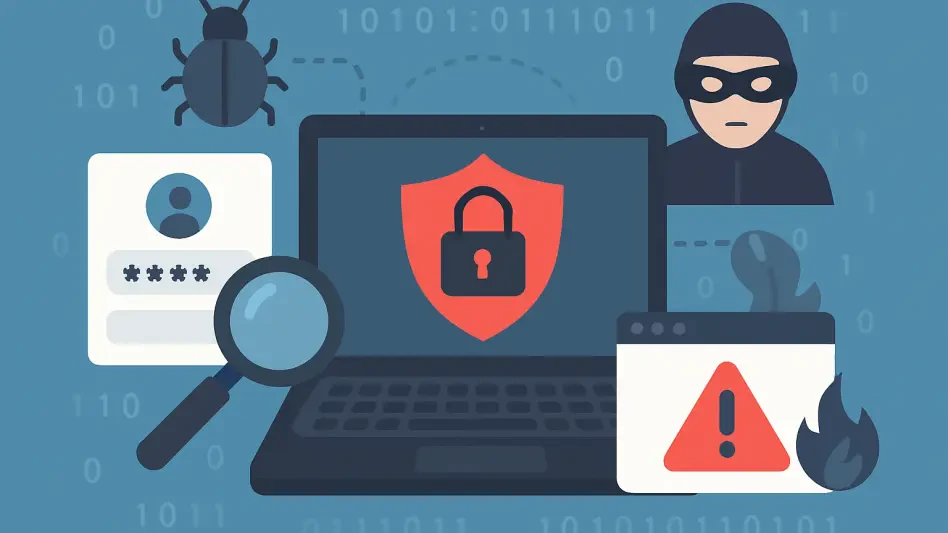In an era where cyber breaches can cost organizations millions and compromise sensitive data in mere seconds, staying ahead of web security risks is non-negotiable. A staggering report from recent industry analysis revealed that over 60% of data breaches stem from vulnerabilities in web applications, underscoring a pressing need for robust defenses. At the heart of this battle lies the OWASP Top 10 list for 2025, unveiled at the Global AppSec conference, serving as a critical benchmark for identifying the most urgent threats. This roundup gathers diverse perspectives, tips, and analyses from cybersecurity professionals and community contributors to dissect the latest list, offering a comprehensive look at persistent dangers and emerging challenges. The purpose here is to distill actionable insights and varying viewpoints to equip security teams with the knowledge needed to fortify their systems.
Exploring the OWASP 2025 Top 10: A Global Security Standard
The OWASP Top 10 list, a cornerstone of web application security since its inception over two decades ago, continues to guide organizations in prioritizing their defense strategies. Released this year at a major industry conference, the list draws from extensive community data and millions of vulnerability records to highlight the most critical risks. Industry leaders emphasize its role not as a static checklist but as a dynamic framework that evolves with the threat landscape, reflecting real-world challenges faced by developers and security experts alike.
Differing opinions exist on its application, with some professionals viewing it as a foundational training tool, while others argue it should be deeply integrated into every stage of software development. A consensus, however, emerges around its value in raising awareness about systemic issues rather than isolated exploits. This roundup delves into these perspectives, comparing how various stakeholders interpret the list’s significance in shaping cybersecurity policies across sectors.
A key point of discussion is the balance between addressing long-standing risks and adapting to novel threats, as reflected in the updated rankings and categories. Contributors from global security forums suggest that the list’s community-driven approach ensures relevance, capturing trends that proprietary reports might overlook. This section sets the stage for a deeper analysis of specific risks, drawing from a spectrum of expert insights to navigate the complex digital security terrain.
Breaking Down the OWASP 2025 Top 10 Risks: Diverse Perspectives
Persistent Challenge: Broken Access Control Dominates Again
Broken Access Control remains at the pinnacle of the OWASP 2025 list, identified by many in the security field as the most pervasive risk due to its potential for unauthorized data exposure and system breaches. Community contributors highlight that failures in authorization mechanisms often stem from inadequate testing, allowing attackers to bypass restrictions with alarming ease. Real-world incidents, such as breaches in financial platforms, are frequently cited as evidence of its devastating impact.
Some cybersecurity veterans argue that the persistence of this risk reflects a systemic failure to prioritize robust access policies over convenience in application design. Others point out that while tools for detecting such vulnerabilities have improved, implementation lags behind, with many organizations still relying on outdated practices. Tips from seasoned professionals include adopting a deny-by-default approach and rigorously mapping access privileges to minimize exposure.
A contrasting view from application developers suggests that the complexity of modern systems, with numerous user roles and permissions, complicates mitigation efforts. They advocate for automated testing integrated into development pipelines to catch issues early. This diversity in thought underscores the multifaceted nature of tackling Broken Access Control, urging a blend of policy and technology to address it effectively.
Escalating Threat: Security Misconfiguration Climbs the Ranks
Security Misconfiguration has surged to the second spot on the 2025 list, a rise that many experts attribute to the growing complexity of cloud environments and hybrid infrastructures. Common issues like exposed credentials and unpatched systems are flagged as preventable yet rampant, with case studies showing how misconfigured databases have led to massive leaks. Community forums buzz with frustration over organizations neglecting basic hardening practices.
Analysts from security consultancies stress that this risk’s climb signals a gap in configuration management, often due to rushed deployments or lack of expertise. Their advice centers on systematic audits and leveraging automation to ensure consistent settings across environments. They warn that ignoring this area can turn minor oversights into catastrophic breaches, as seen in several high-profile incidents.
On the other hand, some IT administrators argue that the responsibility partly lies with vendors who ship products with insecure default settings, pushing for industry-wide standards to enforce better baselines. Their practical tip is to maintain detailed configuration documentation and conduct regular reviews. This range of opinions highlights a shared urgency to address Security Misconfiguration through both technical solutions and cultural shifts in accountability.
Growing Alarm: Software Supply Chain Failures Gain Prominence
Redefined and elevated to the third position, Software Supply Chain Failures have captured significant attention in the 2025 list, driven by notorious incidents that exposed vulnerabilities in third-party components. Security researchers note a sharp rise in attacks targeting repositories on popular platforms, exploiting trust in shared codebases. This risk’s prominence reflects a broader awakening to the interconnected nature of modern software ecosystems.
Some industry voices caution against assuming third-party libraries are inherently secure, advocating for rigorous vetting processes and continuous monitoring of dependencies. They cite the need for tools that can flag malicious updates or compromised packages before integration. Their perspective emphasizes proactive defense, viewing supply chain security as a collective responsibility across development communities.
Conversely, a segment of open-source contributors argues that the burden shouldn’t fall solely on end-users, pushing for repository maintainers to enhance security protocols at the source. Their recommendation includes adopting digital signatures for code authenticity. These differing stances reveal a critical dialogue on shared accountability, urging organizations to rethink how they manage external software components.
Fresh Concern: Mishandling Exceptional Conditions Makes Debut
Debuting at number ten, Mishandling of Exceptional Conditions addresses often-overlooked flaws like race conditions and replay attacks, catching the eye of security architects for its focus on application resilience. Many in the field see this as a timely addition, reflecting a shift toward designing systems that gracefully handle unexpected scenarios. Its inclusion sparks discussions on the need for deeper error-handling strategies.
Experts in application security predict that this risk will grow in relevance as systems become more distributed and asynchronous, increasing the likelihood of such conditions. They suggest incorporating stress testing and failure simulations into development cycles to uncover potential weaknesses. This forward-thinking approach aims to build robustness into the core of applications.
A differing opinion from some developers highlights the challenge of balancing performance with comprehensive error management, noting that over-engineering solutions can slow down systems. Their practical advice is to prioritize critical paths and implement rate-limiting measures to mitigate specific threats like replays. This variety of insights illustrates the nuanced implications of this emerging risk, pushing for tailored strategies in application design.
Key Lessons and Practical Tips for Mitigating Risks
Synthesizing the insights from various security professionals, the standout risks in the 2025 OWASP Top 10 list include enduring threats like Broken Access Control and rising concerns such as Software Supply Chain Failures. A common thread across opinions is the importance of embedding security into the software development lifecycle, rather than treating it as an afterthought. Recommendations often include regular training for teams to stay updated on evolving threats and best practices.
Practical strategies vary, with some experts championing the adoption of automated tools for continuous vulnerability scanning and configuration checks, particularly to combat Security Misconfiguration. Others emphasize policy-driven approaches, such as enforcing strict access controls and validating all external components to address supply chain risks. These tips collectively aim to create a layered defense that adapts to diverse attack vectors.
A notable divergence arises in prioritizing resources, with certain voices advocating for targeted fixes on high-impact risks, while others push for a holistic security culture that addresses even lower-ranked issues like Mishandling of Exceptional Conditions. Despite differences, the consensus leans toward fostering collaboration between developers, security teams, and third-party vendors to build resilient systems. This roundup of strategies offers a toolkit for organizations to customize their security posture based on specific needs.
Reflecting on the Insights Gathered
Looking back on the discussions surrounding the OWASP 2025 Top 10 list, it becomes clear that the cybersecurity community unites in recognizing both persistent and emerging web application risks through a collaborative lens. The varied perspectives on Broken Access Control, Security Misconfiguration, Software Supply Chain Failures, and Mishandling of Exceptional Conditions paint a picture of a field grappling with complex, interconnected challenges. Each insight contributes to a richer understanding of how these threats manifest and evolve in real-world scenarios.
As a next step, organizations are encouraged to leverage the OWASP framework as a springboard for tailored security programs, integrating automated tools and fostering cross-team education to stay proactive. Exploring additional resources, such as community-driven OWASP chapters and detailed mitigation guides, offers a pathway to deepen expertise. This collective wisdom underscores the power of shared knowledge in building stronger digital defenses against an ever-shifting threat landscape.








